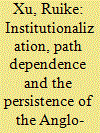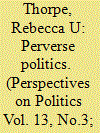|
|
|
Sort Order |
|
|
|
Items / Page
|
|
|
|
|
|
|
| Srl | Item |
| 1 |
ID:
101414


|
|
|
|
|
| Publication |
2011.
|
| Summary/Abstract |
This study examines the time series behaviour of oil production for OPEC member countries within a fractional integration modelling framework recognizing the potential for structural breaks and outliers. The analysis is undertaken using monthly data from January 1973 to October 2008 for 13 OPEC member countries. The results indicate there is mean reverting persistence in oil production with breaks identified in 10 out of the 13 countries examined. Thus, shocks affecting the structure of OPEC oil production will have persistent effects in the long run for all countries, and in some cases the effects are expected to be permanent.
|
|
|
|
|
|
|
|
|
|
|
|
|
|
|
|
| 2 |
ID:
153086


|
|
|
|
|
| Summary/Abstract |
The effects of military spending has on the economy continues to be a subject of considerable debate, with a lack of consensus in the literature. This paper takes advantage of the Stockholm International Peace Research Institute extended data-set to contribute to the debate using empirical methods made available, or more applicable, by the extra observations. It constructs a large panel of countries for the period 1970–2014 to explore the long-run equilibrium relationship between military spending and economic growth, applies the more flexible pooled mean group estimator, and compares the results with the more restrictive dynamic fixed effect method used in earlier influential studies. It also compares results from different time and country samples. Across the specifications it finds a significant and persistent negative effect of military burden on economic growth that is robust across different country groups, with the largest impact being for OECD countries.
|
|
|
|
|
|
|
|
|
|
|
|
|
|
|
|
| 3 |
ID:
184236


|
|
|
|
|
| Summary/Abstract |
We investigate persistence and determinants of deaths from conflicts in a sample of 163 countries for the period 2010–2015. The empirical evidence is based on the Generalized Method of Moments. First, the findings are contingent on income levels, religious domination, landlockedness, regional proximity, and legal origins. We find that the persistence of deaths in internal conflict is more apparent in coastal, French civil law, and Islam-oriented countries, compared to landlocked, English common law, Christian-oriented countries, respectively. Second, the following factors are generally responsible for driving deaths from internal conflicts: homicides, conflict intensity, and conflicts fought. Furthermore, incarcerations have negative effects on internal conflicts. Justifications for the established tendencies and policy implications are discussed.
|
|
|
|
|
|
|
|
|
|
|
|
|
|
|
|
| 4 |
ID:
111388


|
|
|
|
|
| Publication |
2012.
|
| Summary/Abstract |
This study examines the degrees of time persistence in U.S. total renewable energy consumption using innovative fractional integration and autoregressive models with monthly data from 1981:1 to 2010:10. The results indicate that renewable energy consumption is better explained in terms of a long memory model that incorporates persistence components and seasonality. The degree of integration is above 0.5 but significantly below 1.0, suggesting nonstationarity with mean reverting behavior. The presence of long memory behavior (persistence) in renewable energy consumption suggests that random shocks may very well move renewable energy consumption from pre-determined target levels for a period of time.
|
|
|
|
|
|
|
|
|
|
|
|
|
|
|
|
| 5 |
ID:
148461


|
|
|
|
|
| Summary/Abstract |
One of the remarkable phenomena in post-Cold War world politics is the persistence of the Anglo-American special relationship (AASR) in spite of recurrent announcement of its death by pessimists. Current scholarship on Anglo-American relations largely draws on interests and sentiments to explain the persistence of the AASR, ignoring other important contributing factors such as institutionalization. This article is the first to give serious consideration to the role of institutionalization in influencing the persistence of the AASR. By using the concept of path dependence, this article argues that the high-level institutionalization in Anglo-American intelligence, nuclear and military relations plays a seminal role in contributing to the persistence of the AASR in the post-Cold War era. The institutionalized intelligence relationship is exemplified by the relationship between the UK's Government Communications Headquarters (GCHQ) and the US's National Security Agency (NSA), which is underpinned by the UKUSA Agreement. The institutionalized nuclear relationship is exemplified by a variety of Joint Working Groups (JOWOGs), which is underpinned by the 1958 Mutual Defence Agreement. The institutionalized military relationship is exemplified by routinized military personnel exchange programmes, regular joint training exercises and an extremely close defence trade partnership. The high-level institutionalization embeds habits of cooperation, solidifies interdependence and consolidates mutual trust between the UK and the US in their cooperation on intelligence, nuclear and military issues.
|
|
|
|
|
|
|
|
|
|
|
|
|
|
|
|
| 6 |
ID:
172144


|
|
|
|
|
| Summary/Abstract |
This paper contributes to the analysis of the impact of military spending and corruption on economic growth, by considering not only the political dimension of corruption, distorting the allocation of resources to sectors, but also the impact on the efficiency of the bureaucratic environment. It does this by developing the model of Mauro (2004) in the context of an endogenous growth model to deal with corruption in the defence sector. It then uses data from the International Country Risk Guide to produce a novel measure of corruption that combines corruption within the political system, institutional strength, quality of bureaucracy and the degree of military participation in the country and estimates the model for a large panel of countries. The results suggest that both military spending (as a share of total government spending) and corruption have significant negative long run effects on output. As the model also suggests that multiple equilibria can exist, a comparison is made between high and low corruption groups of countries and clear differences are indeed found. This suggests that effort is needed to encourage and coerce high corruption and military spending countries, but low corruption and military spending countries are likely to need little attention.
|
|
|
|
|
|
|
|
|
|
|
|
|
|
|
|
| 7 |
ID:
141306


|
|
|
|
|
| Summary/Abstract |
I examine the political consequences of prison development in the United States. I theorize that the prison apparatus not only upholds a system of racial hierarchy and class stratification, but also links the economic stability of lower-class, rural whites to the continued penal confinement of poor, urban minorities. Analysis of an original dataset suggests that local reliance on existing prison infrastructure throughout many economically-depressed rural communities strengthens political support for harsh criminal punishments and militates against reform efforts. Political representatives have powerful interests in protecting rural prison investments, regardless of their actual economic impact in host communities. The evidence indicates that rural prison development contributes to the perceived economic viability and political power of rural areas, while reinforcing forms of punishment that destabilize poor urban neighborhoods and harm politically marginalized populations.
|
|
|
|
|
|
|
|
|
|
|
|
|
|
|
|
| 8 |
ID:
147334


|
|
|
|
|
| Summary/Abstract |
The article analyses the behaviour of net total capital inflow and its components since the introduction of liberalisation in India in 1991. An introspective analysis of capital flow reveals that capital inflow in India is volatile in nature and it is volatile in exactly the wrong direction, in a sense that it is pro-cyclical rather than countercyclical. However, all types of flows should not be treated equally. Being the most volatile and least persistent components, FPI and commercial bank inflow should be monitored very cautiously. The volatility of foreign direct investment (FDI) and commercial borrowing has gradually increased, although it has declined recently. External assistance has declined steadily and lost its dominance relative to the other counterparts. There is ample evidence of complementarity among the components of capital flows though we get a glimpse of substitutability between FDI and FPI—the two most voluminous components of capital flows. Contrary to a-cyclical, non-debt creating flows, commercial borrowings and commercial bank flows are found to be pro-cyclical in nature. The net total capital inflow series contain three structural breakpoints, at 1995Q4, 2002Q4 and 2006Q2. Domestic growth performance, policy changes and external shocks are the key factors behind these obtained structural breaks. There was a noticeable change in the behaviour of total capital flow and its components over the four phases identified in the article.
|
|
|
|
|
|
|
|
|
|
|
|
|
|
|
|
|
|
|
|
|